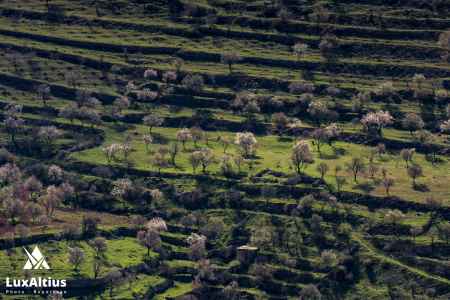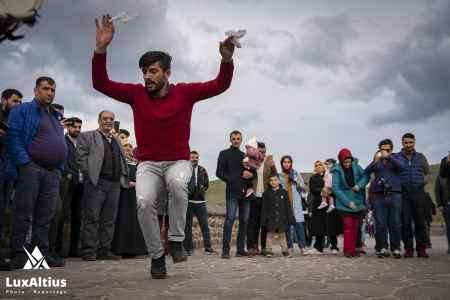Post Tenebras Lux - before leaving Turkey

Mesopotamia flat lands after Anatolian snows.
Here is the 2nd chapter of my journey from Switzerland to Iraq.
[CLICK on the pictures for HD version.
Pour la version française, voir plus bas]
Dear family, friends and supporters,
It is now 28 days since I left from Switzerland (1st episode). Crossing the Balkans and then Turkey was an adventure in itself full of interesting and enriching encounters.
As regards the crowd-funding appeal. This has actually reached and even exceeded its target. And I am really grateful for your support. Thank you so much.
Since being here in Kurdistan, my focus has evolved as new opportunities have become apparent. Not that of relaying further the wreckage of Daech, the atrocities and the plight of the women and children of jihad, even if inevitably such observations are unavoidable. Rather, I plan to concentrate on what might be the future outlook for the region. Hopefully, uncovering stories showing evidence of hope in the different fields of activity, such as politics, society, culture and the arts.
Now.
My last news (from Van) indicated that my intention of taking the uncertain mountainous route to the city of Diyarbakir. However, people here assured me that the snowbound roads were unlikely to be negotiable. I ran the risk of becoming bogged-down in a prolonged winter, both seasonal and linguistic, amid isolated villages.
So, faced with the imperative of arriving in Erbil in time for the Newroz, Berivan and I put off tackling the tough route (on the way back perhaps?) and opted for the bus. We did however take the time to visit the Island of Akdamar, with its 10thcentury Armenian cathedral of the Saint Cross. Once the seat of the ancient and repressed Catholicosate of Aghtamar (an independent see of the Armenian apostolic church) it owes its survival to its position in Lake Van and the pink, volcanic andesite rock out of which it is built. Under not-quite blossoming almond trees is a cemetery with bas-relief sculptures. The steles express a refinement snatched from times of uncertainty and discord, while mineral astragals impose their inconquerable grace on the growth of a land’s hostile moss.
The road to Diyarbakir wound its way between frozen verges and uncompromising checkpoints. The city itself, considered to be the spiritual and political heartland of the Turkish Kurds, makes a mixed impression. On one hand, the walls of basalt dating from the ancient ‘Black Amid’ (classified as a world heritage site), the magnificent Great Mosque of Syrian Omayyad architecture, millenary gardens and the rhythmic play of arches constituting the bridge across the Tigre. On the other hand, the scars of the government’s 2016-2017 military repression of the PKK (Kurdish freedom guerrillas), with a part of the historic city centre and residential areas razed for obvious political motives. Under the orange glow of an old radiant heater, accompanying sheep’s cheese and chickpea with the Assyrian black wine, committed artists confided with us, describing their fears and hopes.
Dominating the Syrian plains of Mesopotamia, the city of Mardin exudes a lighter atmosphere. Its sand-coloured ramparts, its white coffee and signs of ancient Judaism, Yazidi, Armenian and Syrian cohabiting there give an illusion of tranquillity. But the discrete presence of a Turkish garrison in the citadel, and a passage control at Hasankeyf, the semi-troglodyte, ten-thousand year-old town betray the regime’s iron hand. Cradle of the Mesopotamian civilisation, sections of the caves and the citadel are being emerged by the damming of the Tigre. A drab, grey agglomeration has been erected on higher ground to substitute for the drowned ancient city.
What is there to lose by imagining certain universal values which might stifle conflicts, disorder and barbarity? Notably music? Here one can never avoid the audible. Whether it be the screeching decibels of taxis, the almighty call of the Muezzin or the rhythms emitted from every inhabited corner. Then there is the moving sensation to be had from the sounds emerging from the ancient walls of an Assyrian monastery. The rattling of the incense-burning thurible as it accompanies the chants, vespers, hushed and echoing. Eavesdropping on such ritual feels almost like desecrating the crumbling pages of an ancient manuscript. Such is the feeling of communicating with another epoch. An experience I had when improvising a Gregorian chant while visiting the Church of St. Croix at Akdamar.
Another universal value is that of rural gestures and scenes. My heart warms to the observation of ancestral farming practices. Or when one perceives that smile from a shepherd, so similar be it in the Alps, the Balkans or elsewhere. Just as it must be from the initial time of agriculture that began in this same area.
Contrasting with such spiritual considerations, my next mail will recount the rest of my Iraqi experience. I write to you from a failed state. Fortunately feeling solid and ready to move on.
I send you my best wishes.
Christopher
FRANCAIS:
[CLIQUEZ SUR LES PHOTOS pour les voir en haute définition]
Cher tous,
Nous avons dépassé les 100% pour la campagne de crowdfunding. Encore une fois, un très grand merci à tous !
Depuis mon entrée au Kurdistan irakien, le reportage prend un nouveau tournant et de nouvelles opportunités se sont offertes. L’idée n'est désormais pas tant de couvrir ce qui a été déjà vu et revu, les atrocités, les femmes et enfants du jihad, bien que je serai nécessairement amené à les croiser. Mais plutôt d’essayer d’entrevoir des perspectives d’avenir et de délier le fil d’histoires plus optimistes. Sur les plans politique, culturel, social ou artistique.
Mon dernier compte-rendu laissait entendre que j’allais traverser des contrées blanches et à la cartographie routière incertaine. On m’assura que la route n’était pas passable et qu’une errance parmi des hameaux coupés du monde après décembre allait assurément m’embourber dans un hiver saisonnier autant que linguistique.
Devant l’échéance du Newroz, je jugeai ces obstacles dignes d’être tentés plus tard pendant le retour, après l’Iraq. Et nous choisîmes la facilité du bus pour Diyarbakir. Mais après une halte sur l’île d’Akdamar, retraite de l’église arménienne de Sainte-Croix. Vestige plus que millénaire, l’ancien siège du catholicossat d’une civilisation réprimée doit son bon état à son emplacement ainsi qu’à l’andésite rougeoyante qui la compose. Sous les amandiers à peine en bourgeons, le cimetière et ses bas-reliefs. Les stèles expriment un raffinement soustrait aux aléas du temps et de la discorde. Les astragales minérales arrachent aux mousses d’une patrie hostile leur grâce nonpareille.
Dans un bus encombré par le désir d’ailleurs, la route pour Diyarbakir nous fit sinuer entre des versants figés par le froid et des checkpoints inflexibles. Une fois arrivés, la capitale spirituelle et politique de cette région kurde de Turquie me frappa d’impressions inégales. D’une part les murailles de basalte de l’antique « Noire Amida » classées au Patrimoine mondial, les fastes de la Grande Mosquée d’architecture syrienne omeyyade, les jardins millénaires et l’entrain des danses sur les arches qui enjambent le Tigre. D’autre part les cicatrices de la répression militaire anti-PKK (la guérilla kurde) de 2016-2017, une partie du centre historique et résidentiel ayant été littéralement rasée pour des raisons évidentes de supervision politique. Dans la lueur orangée d’un chauffage radiant, savourant un vin noir assyrien, un fromage de brebis et des pois chiches soufflés, des artistes engagés nous partagèrent leurs craintes et leurs espoirs.
Dominant les plaines syriennes de Mésopotamie, la ville de Mardin semble plus volage. Ses rempart couleur de sable, son café blanc et les témoins d’un syncrétisme judaïque, yezidi, arménien et syriaque donnent l’illusion d’une quiétude radieuse. Mais la présence presque furtive d’un contingent de soldats turcs condamne la citadelle qui surplombe la ville. Et un passage à Hasankeyf, ville mi-troglodyte de plus de 10 000 ans, illustre l’emprise de la main de fer du régime. Berceau de la civilisation mésopotamienne, une partie des grottes et de la citadelle est en train d’être submergée suite à l’érection d’un barrage sur le Tigre. Une agglomération grise a été établie plus haut, censée pallier le naufrage de la cité antique.
Me risquerai-je toutefois à rêver à certains universels qui subliment les conflits, les troubles, les horreurs ? La musique, notamment. On ne peut y échapper ici. Qu’il s’agisse des décibels crachés par les taxis, des appels du muezzin panoptique ou des sarabandes en tout lieu. Plus encore, comment ne pas frémir lorsque, collant l’oreille à la porte d’un monastère assyrien, surgit une rumeur. Émanant de murs immémoriaux, le tintinnabulement d’un encensoir en scandant les phrases, des vêpres, sourds et caverneux. Comme la sensation de profaner les pages d’un manuscrit qui se délite. Ou de communiquer avec d’autres âges, comme en l’église de Sainte-Croix où je me risquai à une improvisation grégorienne que je me réjouis de partager avec vous.
Autre universel, le geste et les scènes rurales. Comment ne pas s’émerveiller devant la reconnaissance de tel usage et de telle pratique paysanne ancestrale. Ou lorsque le visage d’un berger esquisse un sourire qui m’est familier, déjà perçu dans les Alpes, les Balkans ou ailleurs. Comme une communauté laborieuse, originelle. Après tout, nous voici bien là à la source de l’agriculture.
Tranchant un peu avec ces considérations peut-être un peu spirituelles, mon prochain mail relatera la suite irakienne. Je vous écris depuis un État failli, mais les reins bien à l’aise, comme aurait dit Rabelais.
Avec toute ma reconnaissance,
Christopher













